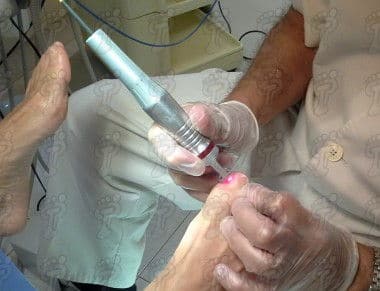In the present study we are focused on our experience about the use of laser as the most current therapeutic system in the treatment of the onychomycosis as well as the results got through the therapeutic synergy of laser with the antimycotic topical treatment.
The onychomycosis is an infectious disease which affects to the nail in consistency, smell, thickness and color. The main infectious agents are the dermatophyte fungi (Trichophyton and Microsporum) followed by yeasts (Candida Albicans) and no dermatophyte molds (Aspergilus).
It affects to 4% of world population and it is the most frequent unguinal disease in developed countries. It has an aesthetic affectation although it may become worse in groups of risk like diabetic patients, immunodepressed or with peripheral vasculopathies.
The prevention is based on a correct daily hygiene, drying of foot, use of socks and shoes which will favor the transpiration as well as the use of personalized unguinal cutting means.
It is classified in five groups:
− Distal and lateral subunguial onychomycosis : it is the most frequent. They are slow infections which affect to the color and thickness of the unguinal lamina.
− Proximal subunguial onychomycosis : the infection starts in the cuticle and it moves forward to the unguinal edge. It is not very common in healthy people.
− Total dystrophic onychomycosis : of slow development, they cause an hyperkeratosis in the hyponychium as well as thickness, a change in color or total unguinal devitalization.
− White superficial onychomycosis : as this definition says, the infection shows a whitish color which invades the surface of the nail causing it a rough appearance.
− Candidiasic onychomycosis : it shows an inflammation and pain in the sulcus matricis unguis, degenerating a distal and lateral onychomycosis.
AIM OF THE SURVEY
The aim of this survey is to contrast the effectiveness degree in onychomycosis of laser treatment versus laser compound and a topical antimycotic.
MATERIALS AND METHODS
The laser which we use in our treatment is a laser of 1064 nanometers wavelength and 40 W power (S 30 Podylas TM) which works as an antimycotic respecting the surrounding tissues and without side effects.
The antimycotic which we use in the present survey is 5% solution Amorolfine. The Amorolfine is a wide spectrum fungicidal of the Morolphine group. It inhibits the synthesis of the ergosterol from the fungus membrane. It has a high penetration at the level of the unguinal layer and it is given one or twice a week.
Such research has been made to 40 affected patients of onychomycosis by some of the five groups previously described. They are patients from both sexes being 28 women (70 %) and 12 men (30 %). Women’s age ranges from 24 to 84 years old, being the average age about 64 years old while men’s age ranges from 36 to 76 years old, being the average age about 69 years old. One of the main criterion to be admitted is the age of majority and the criterion to be excluded are pregnant women and patients treated with onychomycosis in the last 6 months. All patients which participate in this survey have been diagnosed of onychomycosis through culture. Among 40 patients there are a total number of 48 infected nails.
The laser therapy of the following survey consists of three application sessions with a resting period of 15 days between each session. We make an exhaustive cleaning of the infected nail previously to each session. Those patients who have lasertherapy treatment combined with topical antimycotic, are requested to apply Amorolfine from the first laser session to the complete regeneration of the nail. This means that there are patients who are applied this treatment for 3 months to a maximum period of 9 months (depending both of the unguinal affectation regarding its depth and the speed to grow).
We have set up two researching groups with 20 patients each one:
− Group A : (8 men and 12 women) patients only treated with laser therapy and with a total number of 25 infected nails. The percentage of unguinal affectation is 4 nails with 25 %, 15 nails with 50 %, 4 nails with 75 % and 2 nails with 100 % of the surface.
− Group B: (4 men and 16 women) patients treated with lasertherapy combined with topical Amorolfine and with a total number of 23 infected nails. The percentage of unguinal affectation is about 6 nails with 25 %, 12 nails with 50 %, 2 nails with 75 % and 3 nails with 100 % of the surface.
RESULTS
The group A (only with lasertherapy) had a 76 % of success (19 nails) while the group B (lasertherapy and Amorolfine) had a 86,9 % of success (20 nails). The six recidivations of group A belonged to two nails with 100 % affectation, three nails with 50 % and one nail with 75 % of the surface.
The 3 recidivations of group B belonged to 2 nails with 100 % affectation and 1 nail of 50 %. The distal and lateral subunguial onychomycosis was cured in 96 % of the cases in group A and 95,6 % of the cases in group B.
CONCLUSION
The synergy between the laser application and the topical antimycotic treatment increases the effectiveness index regarding to only the laser treatment. The laser therapy is usually more active in distal and lateral subunguial onychomycosis (fortunately the most common). The result in the total dystrophic onychomycosis is of very limited effectiveness as well as void in those cases of proximal, white, superficial and candidiasic subunguial onychomycosis.
In a nutshell, the laser therapy seems to be a good choice as an antimycotic treatment allowing a lower and more comfortable involvement by the patient in this therapy. The success varies in a high quantity depending on the kind of onychomycosis and its extension.

